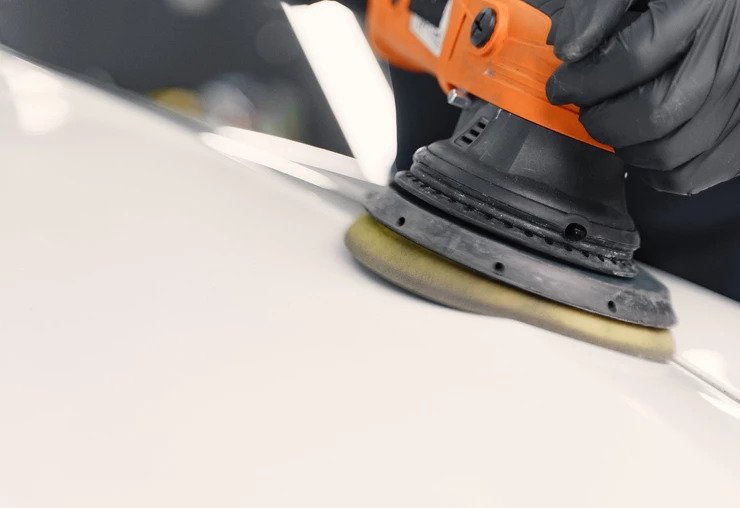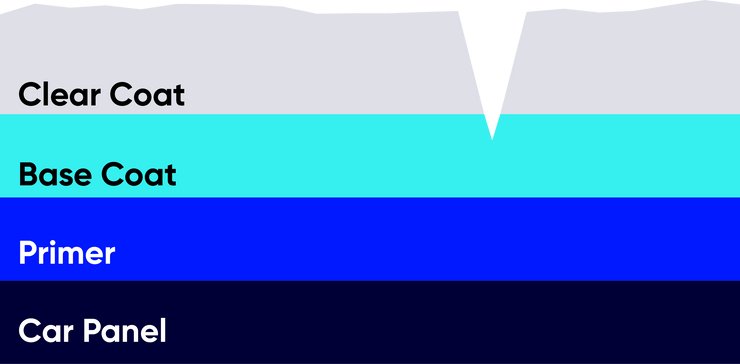
Cutting, polishing, and waxing are three methods of removing scratches on your car. Even though you can hear them being thrown around like they’re one and the same, they are not. There’s a world of difference among the three, especially because interchanging one for the other can potentially cause harm to your car paint. Of course the experts in trusted repair shops such as Flow Autobody already know this like the back of their hand. However, new car owners looking for ways to care for their vehicle may not be as aware. Car wax and polish will be your new best friends after reading this blog.
Before we get down to the specifics, let’s take a look at the 4 layers of car paint. This will help you understand the fundamental differences among the three methods of scratch removal.
Understanding the 4 Layers of Paintwork

Car Panel
This also referred to as the metal substrate and is the bare metal surface layer of your car’s body. In short, this is the innermost layer of your car itself.
Primer
The primer helps the coloured or tinted layer of paint (or even other primers) to adhere to your car’s substrate. Primers, sometimes also called sealers, offer your panels protection against rust and corrosion. They are also used to fill in surface scratches and smoothen out imperfections to be sanded out later on.
Base Coat
This is also called the colour coat. It’s the actual paint of your car which can be applied as a single layer or in multiple ones depending on the effect to be achieved.
Clear Coat
As its name suggests, it’s the clear coat made of paint or resin that’s applied as a varnish to seal in all the layers of coating underneath. In a sense, it ties together all the other layers underneath.
With all that in mind, let’s break down the difference between cutting, polishing, and waxing and how these effect your car’s paintwork.
Difference Between Cutting, Polishing, and Waxing
Car wax and polish can only do so much. What’s more important than having these is knowing the appropriate method to remove the paint damage safely.
Cutting
Cutting is specifically for hard-to-remove scratches, swirl marks, and holograms (micro scratches) on the clear coat. If the damage extends beyond the clear coat, then going for a scratch removal first is ideal.
Polishing
This process, very much like cutting, of makes use of an abrasive material to smoothen out scratches and imperfections on your car’s clear coat and restore its shine. The only difference is that it’s less invasive to cutting as it’s only used for moderate scratches or medium level scratches on the clear coat. Also, polishing doesn’t offer any protection for the car’s paint since it strips away material from the surface.
Cutting and Polishing
These terms are often used in-tandem since both processes are needed in order to effectively restore paintwork that’s in really bad shape (e.g. dullness or chalkiness, oxidation, deep scratches and swirls).
Waxing
Waxing is the process of smoothening out the clear coat surface by filling it in with a layer of protective material which in this case is usually Caranauba wax or Brazil Wax. It enhances and seals in the smooth and reflective finish of Polishing. It’s important your get your newly polished paintwork to be waxed so as to protect it from minor surface scratches (which can be waxed away) and including even UV rays.
One last term that you need to know is the term ‘Buffing.’ Buffing is the term used to describe the use of a buffing pad and buffing compound to restore car’s paint. Buffing can be done using a handheld machine called a buffer or by hand which is more time-consuming and requires more physical effort.
Remember these three things:
- Cut for deep (heavy scratches and damage to the clear coat)
- Polish to sweep (out imperfections with abrasive material)
- Wax to keep (the shiny finish protected and sealed)
These three procedures ensure that your car’s paintwork looks, feels, and stays fresh. The frequency of getting them for your car however, depends entirely on its usage, environmental damage and its existing paintwork quality.
Car Wax and Polish – Which is Better?
Car wax and car polish are actually used together quite often because they complement each other well. Car polish removes a very, very thin layer of the paint to hide light scratches and using car wax after a good polish helps further reduce the appearance of the scratches. Wax can also be used without polishing your car because it also serves as protection to minimize scratches in the future.
There isn’t a better option between the two, but it’s better to use them together if your purpose is to remove scratches. Wax alone can’t do what polish can, but polish can’t protect your car like wax can. They serve different purposes and cannot be compared as if competing products.
So the simplest answer is, neither is better than the other. Car wax is a better option if you just want to bring back the shine of your car and add an extra layer of paint protection. Car polish, on the other hand, is the better option if there are paint scratches. Although not necessary, it is highly recommended to follow car polish with car wax. Car polish first before car wax. Otherwise, you can just stick with good ‘ol polishing alone.
Car Paint Care with Flow Autobody
Want to know more about how to keep your paint looking gorgeous? Head on over to this blog: 3 Easy Tips on How to Protect your Car Paint.
To make it easier for you, why not bring your car to a professional repairer like Flow Autobody? It’s not recommended that you remove serious scratches on your car or any damage that goes deeper than the top coat. Car wax and polish can no longer remove major scratches, no matter how hard you try. Get a free estimate here and get the car care that your vehicle deserves.
If you have any further questions about home car care maintenance offer, please feel free to contact us at [email protected]. You may also visit our services page to see how we can help you with your other car concerns.